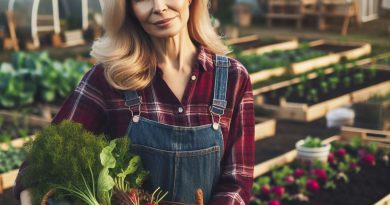Biodynamic Farming: An Organic Approach
Last Updated on January 29, 2024
Introduction
Biodynamic farming is an agricultural approach that emphasizes the holistic interconnection between plants, animals, and the environment.
It goes beyond organic farming by incorporating spiritual and metaphysical concepts.
Biodynamic farmers view their farms as self-sustaining organisms that work in harmony with the natural world.
This method was developed in the 1920s by Austrian philosopher Rudolf Steiner, who believed that farming should align with the rhythms of the Earth and the cosmos.
Biodynamic farmers use specific preparations, such as herbal sprays and compost preparations, to enhance soil fertility and plant health.
They also follow a strict planting and harvesting calendar based on astronomical events.
One of the key principles of biodynamic farming is the belief in the farm as a closed system.
Farmers aim to produce all the necessary inputs on-site, including compost, fertilizers, and animal feed, to reduce reliance on external sources.
Livestock is an essential component, as animals contribute to the overall health of the farm through their manure and natural behaviors.
Biodynamic farmers also prioritize biodiversity and ecological balance.
They often incorporate diverse crops and plant hedgerows to provide habitats for beneficial insects and birds.
By avoiding synthetic chemicals and genetically modified organisms, biodynamic farming aims to protect the health of the soil, water, and surrounding ecosystems.
In fact, biodynamic farming is an organic approach that goes beyond conventional methods.
It recognizes the intimate connection between nature and farming practices, promoting sustainability, spiritual harmony, and biodiverse ecosystems.
Adopting this holistic approach can contribute to a healthier planet and sustainable agricultural systems.
History of Biodynamic Farming
The history of biodynamic farming dates back to the early 20th century. It was founded by Rudolf Steiner, an Austrian philosopher who developed the biodynamic principles.
Steiner believed in the interconnectivity of all living things and sought to create a farming system that worked in harmony with nature.
Steiner’s ideas on biodynamics were first introduced in 1924 as a series of lectures known as the “Agriculture Course.”
These lectures provided a comprehensive framework for biodynamic agriculture, emphasizing the importance of soil health and the use of homeopathic preparations to enhance plant and animal vitality.
Influences and connections to organic farming
One of the key influences on biodynamic farming was the emerging organic farming movement of the time.
Steiner’s teachings were seen as a natural extension of organic principles, which also focused on nurturing the health of the soil and minimizing synthetic inputs.
In fact, many of the early pioneers of organic farming were also practitioners of biodynamics.
Farmers like Lady Eve Balfour and Sir Albert Howard, who laid the foundation for modern organic agriculture, were heavily influenced by Steiner’s teachings.
Biodynamic farming also drew inspiration from other traditional farming practices, such as traditional Chinese medicine and Ayurveda.
These holistic approaches to health and wellness provided additional insights into the interconnectedness of plants, animals, and the environment.
Steiner’s teachings emphasized the importance of biodiversity in farming.
He believed that a diverse array of plants and animals helped create a balanced ecosystem that could naturally resist pests and diseases.
This idea has since been supported by scientific research, which has shown that diverse farming systems are more resilient and sustainable in the long run.
Another key aspect of biodynamic farming is the use of biodynamic preparations.
These preparations are made from natural substances like herbs, minerals, and animal manure, and are used to enhance soil fertility and promote plant growth.
Some of the commonly used preparations include the biodynamic compost preparations, which are made by burying cow horns filled with manure in the soil.
These preparations are believed to help stimulate microbial activity and create a rich, fertile soil environment.
A Sustainable Agricultural Movement Rooted in Rudolf Steiner’s Teachings
Over the years, biodynamic farming has gained recognition and acceptance worldwide.
The biodynamic agriculture movement has established certification and accreditation organizations to ensure the integrity of biodynamic practices.
Many farmers have reported improved soil health, increased crop yields, and reduced dependence on external inputs after adopting biodynamic methods.
Consumers, too, have shown a growing interest in biodynamic produce, recognizing its superior nutritional value and environmental benefits.
In short, the history of biodynamic farming can be traced back to Rudolf Steiner’s teachings in the early 20th century.
Influenced by organic farming and holistic practices, biodynamic farming emphasizes the interconnectedness of all living things and seeks to create a harmonious and sustainable farming system.
As awareness of the environmental and health benefits of biodynamic farming grows, more farmers and consumers are recognizing its value and embracing this organic approach.
Read: Seattle’s Farm-to-Table Scene Unveiled
Principles of Biodynamic Farming
In this section, we will explore the key principles behind biodynamic farming and the various practices that make it a unique and holistic approach to agriculture.
Introduction of the Biodynamic Preparations and their Purpose
Biodynamic farming utilizes specially prepared substances that enhance the overall health and vitality of the farm ecosystem.
- These preparations are made from natural materials such as herbs, minerals, and organic compost.
- They are carefully formulated to stimulate the life forces present in the soil, plants, and animals.
- The purpose of these preparations is to enhance the farm’s self-sustainability and promote harmonious interaction with the environment.
- Each preparation serves a specific function, targeting different aspects of the farm ecosystem.
Description of the Nine Biodynamic Preparations
Biodynamic farming employs nine specific preparations, each with its unique ingredients and purpose.
- Horn Manure (Preparation 500): Made from cow manure buried in cow horns during the winter, it stimulates root development and enhances soil fertility.
- Horn Silica (Preparation 501): Consists of ground quartz crystals packed in cow horns, helps with photosynthesis and overall plant vitality.
- Yarrow Preparation (502): Utilizes yarrow flowers to enhance nutrient absorption and stimulate plant growth.
- Chamomile Preparation (503): Made from chamomile flowers, it promotes seed germination and overall plant health.
- Stinging Nettle Preparation (504): Utilizes stinging nettle plants to enrich the soil, increase microbial activity, and stimulate composting.
- Oak Bark Preparation (505): Made from oak bark, it helps plants withstand diseases and pests while improving overall vitality.
- Dandelion Preparation (506): Utilizes dandelion flowers to enhance composting processes and promote soil health.
- Valerian Preparation (507): Made from valerian flowers, it enhances the farm’s overall balance and resilience.
- Horsetail Preparation (508): Utilizes horsetail plants to control fungal diseases and improve plant structure.
Role of Composting and Soil Health
Composting plays a vital role in biodynamic farming and contributes to the overall health of the soil.
- Composting involves the decomposition of organic materials, resulting in nutrient-rich humus.
- This humus enhances soil structure, promotes water retention, and provides essential nutrients to support plant growth.
- Biodynamic farms maintain a healthy balance of bacteria, fungi, and other microorganisms in the soil through composting.
- These microorganisms break down organic matter, releasing nutrients and contributing to overall soil fertility.
- By nourishing the soil through composting, biodynamic farmers create a vibrant and sustainable foundation for their crops.
Overall, biodynamic farming principles aim to establish a harmonious relationship between the farm, its environment, and the people involved.
Through the use of biodynamic preparations and the maintenance of soil health, biodynamic farmers cultivate thriving ecosystems that promote long-term sustainability and the well-being of all living entities.
Read: SF’s Farm-to-Table Revolutionaries
Biodynamic Farming Techniques
Crop Rotation and Biodiversity
Crop rotation is a crucial technique in biodynamic farming to ensure soil health and fertility.
Farmers strategically rotate crops to prevent the depletion of nutrients and the buildup of pests and diseases.
By alternating crops, farmers can break the lifecycle of specific pests, reducing the need for harmful pesticides.
Additionally, different crops have varying nutrient requirements, which helps maintain a balanced soil ecosystem.
Biodiversity is at the core of biodynamic farming. Farmers strive to create diverse plant and animal communities within their farms.
This approach encourages natural pest control, as beneficial insects thrive in diverse environments.
Moreover, cultivating a wide variety of crops promotes soil health through the absorption of different nutrients, reducing the need for synthetic fertilizers.
Biodiversity also helps increase the resilience of farming systems, making them less vulnerable to climate change and crop failures.
Importance of Lunar and Celestial Cycles
Biodynamic farmers recognize the influence of lunar and celestial cycles on farming activities.
They believe that these cosmic rhythms affect plant growth, development, and overall vitality.
Planting and harvesting according to the lunar calendar is a fundamental practice in biodynamic farming.
Farmers carefully time their activities to align with the moon’s phases, maximizing crop yield and quality.
Moon phases, such as the waxing and waning crescents, influence sap flow, germination, and root growth.
By understanding these rhythms, farmers can optimize their planting and harvesting schedules.
Additionally, biodynamic farmers consider planetary movements and astronomical events.
They believe that these cycles impact the vitality and energy of crops, promoting healthier and more vibrant plants.
Integration of Animals and Plants in Farming Systems
In biodynamic farming, the integration of animals and plants is essential for maintaining a balanced ecosystem.
Animals contribute to nutrient cycling, soil fertility, and pest control.
Livestock, such as cows and chickens, provide manure that serves as a natural fertilizer.
The manure enriches the soil with essential nutrients, reducing the need for synthetic inputs.
Moreover, animals help control pests by consuming insects, larvae, and weed seeds.
This natural pest management approach minimizes the use of chemical sprays, protecting the environment and promoting biodiversity.
Integration also extends to the cultivation of medicinal and pollinator-friendly plants.
These plants attract beneficial insects and support the health of the overall farming system.
Furthermore, the presence of animals and their grazing activities helps maintain optimal vegetation height and prevents excessive weed growth.
They contribute to the overall aesthetics and ecological balance of the farm.
Biodynamic farming techniques encompass crop rotation and biodiversity, lunar and celestial cycle observance, and the integration of animals and plants within farming systems.
These practices prioritize sustainability, soil health, and ecological balance.
By implementing crop rotation and fostering biodiversity, biodynamic farmers promote natural pest control, reduce the need for synthetic inputs, and enhance the resilience of their farming systems.
Mindful adherence to lunar and celestial cycles enables farmers to optimize planting and harvesting schedules and enhance the vitality of their crops.
Integration of animals and plants ensures nutrient cycling, natural pest control, and ecological balance within biodynamic farming systems.
Overall, biodynamic farming is an organic approach that harmonizes with nature, providing sustainable and environmentally-friendly solutions for agricultural practices.
Read: Austin’s Must-Visit Farm-to-Table Spots

Benefits of Biodynamic Farming
Biodynamic farming offers several benefits, making it a compelling choice for both farmers and consumers.
Environmental Benefits
This holistic approach improves soil fertility and enhances biodiversity.
Biodynamic practices promote the use of natural fertilizers and compost, reducing the need for synthetic chemicals.
This not only helps to preserve the soil’s health but also conserves water resources, as organic methods often require less irrigation.
Nutritional Benefits
Biodynamic farming is known for producing high-quality, nutrient-rich produce.
By focusing on building healthy soil, the crops grown in these nutrient-rich soils often contain greater levels of essential vitamins, minerals, and antioxidants.
Studies have shown that biodynamically grown food can have higher nutrient content compared to conventionally grown alternatives.
Enhanced Flavor and Shelf Life
Many consumers find that biodynamically grown produce has a superior taste and texture compared to conventionally grown counterparts.
The careful attention to soil health and plant vitality often results in crops with enhanced flavor profiles.
Additionally, these farming practices can contribute to longer shelf life, reducing food waste and ensuring fresher produce for consumers.
Economic Benefits for Farmers
Biodynamic farming presents significant economic advantages for farmers.
As consumer demand for organic and sustainable products continues to rise, there is a growing market for biodynamic produce.
This increased market demand translates to higher prices for farmers’ products, enabling them to secure better financial returns on their investments.
Soil Regeneration and Long-term Sustainability
Biodynamic farming is focused on regenerating the soil rather than depleting it.
This approach prioritizes the long-term sustainability of agricultural practices by enhancing soil health, promoting biodiversity, and minimizing chemical input.
By taking care of the land, biodynamic farmers ensure its productivity for future generations.
Resilience against Climate Change
Biodynamic farming methods strengthen the resilience of the agricultural system to climate change.
By enhancing soil structure and fertility, these practices help to retain moisture and reduce soil erosion.
This system also encourages planting a diverse range of crops, which can be more resilient to climate fluctuations and pests.
Positive Impact on Surrounding Ecosystems
Biodynamic farming recognizes the interconnectedness of the land, plants, animals, and humans.
By promoting biodiversity and creating a harmonious environment, biodynamic farms become hubs for diverse wildlife, including beneficial insects and pollinators.
This fosters a healthier ecosystem and contributes to the preservation of critical habitats.
Reduced Chemical Exposure
Biodynamic farming minimizes the use of synthetic chemicals, reducing the exposure of farmers, farm workers, and consumers to potentially harmful substances.
This promotes a safer working environment for farmers and contributes to healthier food options for consumers.
Basically, biodynamic farming offers a wide range of benefits.
From promoting environmental sustainability and soil fertility to enhancing crop quality and market value, this organic approach supports the overall well-being of the farming community and the planet.
The holistic perspective of biodynamic farming fosters a harmonious relationship between humans, plants, animals, and the ecosystem, making it an appealing choice for individuals seeking healthier and more sustainable agricultural practices.
Read: Denver’s Peak Farm-to-Table Experiences
Challenges and Criticisms of Biodynamic Farming
Lack of scientific evidence for some practices
Biodynamic farming embraces methods that have not been scientifically proven, such as cosmic influences and preparations made from animal organs.
Critics argue that relying on unverified practices compromises the credibility of biodynamics.
Time-consuming and labor-intensive methods
Biodynamic farming demands significant time and effort from farmers.
Preparing and applying various composts, compost teas, and sprays, as well as following lunar and astronomical calendars, require careful attention and laborious work.
Potential resistance from conventional farming methods
Conventional farming practices, driven by technological advancements and maximizing yields, may show resistance towards biodynamic farming.
The two methodologies often clash in terms of approaches, leading to skepticism and hesitation in adopting biodynamics.
Complexity of preparations and applications
Biodynamic farming involves intricate preparations and applications, which can be overwhelming for farmers new to this approach.
Preparations like horn manure and horn silica necessitate specific procedures and precise timing, making them difficult to master.
Reliance on external sources for preparations
The preparations used in biodynamic farming often require sourcing materials externally, such as animal organs and specific herbs.
This reliance can pose challenges for farmers, as finding high-quality and diverse ingredients might be difficult or costly.
Lack of standardized practices and certification
Unlike organic farming, which has established standards and certifications, biodynamic farming lacks universal guidelines.
This absence raises concerns about quality control and credibility within the industry.
Limited scalability for large-scale farming operations
Biodynamic farming methods are often viewed as more suitable for smaller-scale operations.
Implementing these practices on a large scale can be impractical and may not align with the economic demands of industrial agriculture.
Skepticism and dismissal from the scientific community
Some members of the scientific community have criticized biodynamics for lacking empirical evidence and relying on pseudoscience.
This skepticism can hinder wider acceptance and integration of biodynamic practices in conventional agriculture.
Reputation for being esoteric or mystical
Biodynamic farming’s reliance on cosmic and spiritual elements can cause it to be labeled as esoteric or mystical.
This perception may prevent farmers from considering biodynamics as a viable approach.
Therefore, despite its numerous advantages, biodynamic farming also faces several challenges and criticisms.
The lack of scientific evidence for some practices, the time-consuming and labor-intensive methods, and potential resistance from conventional farming methods pose obstacles to its widespread adoption.
Additionally, the complexity of preparations, reliance on external sources, lack of standardized practices, limited scalability, skepticism from the scientific community, and reputation for being esoteric all contribute to the challenges faced by biodynamic farming.
Nevertheless, continued research, education, and open dialogue between proponents and skeptics can help address these challenges and further improve and refine the implementation of biodynamic farming methods.
Case Studies and Success Stories
Biodynamic farming has gained popularity in recent years due to its numerous benefits for the environment and the quality of the produce.
In this section, we will explore some examples of successful biodynamic farms and wineries, as well as real-life experiences from farmers who have adopted biodynamic practices.
Examples of Successful Biodynamic Farms or Wineries
- Rudolf Steiner Farm: Located in Germany, this biodynamic farm has been operating for over 50 years.
- Domaine de la Romanée-Conti: This famous winery in Burgundy, France, has been following biodynamic principles since 1986.
- Apricot Lane Farms: Situated in California, USA, this diverse biodynamic farm has achieved remarkable success in sustainable agriculture.
- Montinore Estate: Located in Oregon, this biodynamic vineyard produces high-quality wines using holistic farming practices.
- Farms for City Children: This UK-based charity runs three biodynamic farms, providing educational and sustainable experiences for children.
These examples demonstrate that biodynamic farming can be implemented successfully across different regions and agricultural sectors.
Real-Life Experiences from Farmers
Several farmers have adopted biodynamic practices and have witnessed significant positive changes in their farming operations.
Here are some inspiring stories:
- John Anderson, a dairy farmer in New Zealand, converted his conventional farm to biodynamic methods and saw improved soil fertility and healthier cows.
- Maria Lopez, a vegetable farmer in Spain, noticed a decrease in pests and diseases after transitioning to biodynamic farming, reducing her reliance on pesticides.
- David Smith, a grape grower in California, found that biodynamic practices enhanced the flavor profiles of his wines, leading to increased demand and recognition.
- Sarah Johnson, an orchardist in Australia, implemented biodynamic preparations and observed improved fruit quality and prolonged storage life.
- Carlos Morales, a coffee farmer in Colombia, experienced higher yields and better pest resistance after adopting biodynamic principles, leading to economic stability.
These success stories highlight the transformative impact of biodynamic farming on different types of agriculture and the overall well-being of farmers.
In review, case studies and success stories provide concrete evidence of the effectiveness of biodynamic farming.
By showcasing successful biodynamic farms and real-life experiences from farmers, we can inspire others to embrace this organic and sustainable approach to agriculture.
Conclusion
Biodynamic farming offers a holistic and organic approach to agriculture.
It integrates sustainable practices, such as crop rotation, composting, and natural pest control, to promote soil health and biodiversity.
By considering the interconnectedness of plants, animals, and the environment, biodynamic farming aims to create a self-sustaining ecosystem.
Throughout this blog section, we have discussed the various aspects of biodynamic farming and its benefits.
We explored the use of biodynamic preparations, which enhance soil fertility and stimulate plant growth.
We also discussed the importance of lunar cycles and cosmic rhythms in biodynamic farming practices.
It is crucial for readers to support and explore biodynamic farming.
With increasing concerns about the impact of conventional agricultural practices on the environment, biodynamics offers a sustainable and regenerative alternative.
By choosing biodynamic products and supporting biodynamic farms, we contribute to the preservation of biodiversity and the protection of our planet.
Furthermore, biodynamic farming not only benefits the environment but also produces healthier and more nutritious food.
By avoiding the use of synthetic chemicals, biodynamic farmers prioritize the quality of their produce.
Consuming biodynamic products ensures that we nourish our bodies with clean and wholesome food.
In a nutshell, biodynamic farming presents a compelling and effective approach to sustainable agriculture.
Its emphasis on ecological balance, biodiversity, and holistic practices offers a promising solution to the challenges faced by conventional farming methods.
By embracing biodynamic principles, we can contribute to a healthier planet and a more sustainable future for generations to come.


